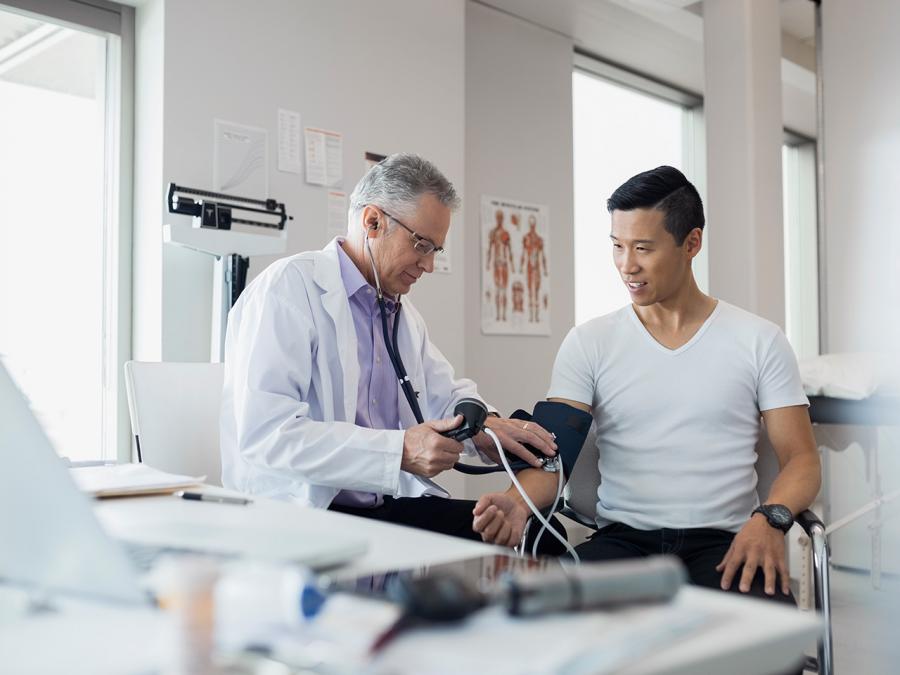MAN GETTING BLOOD PRESSURE CHECKED
Start the year with a clean bill of health: All you need to do is pass these fast and painless tests to ensure you’re on track for a long, healthy life—and don’t worry, no latexed finger or cold tube up your poop chute required (you’re too young to screen for prostate or colon cancers).
Take it from Stephen Dahmer, M.D., a family physician at the Continuum Center for Health and Healing in New York City, who will check off these tests on his own to-do list in the new year.
Here are five essential health tests you should take—especially if you’re under 40.

1. TESTICULAR SCREENING
While the odds of developing testicular cancer are low (it accounts for only 1% of all cancers), it is the most common kind in men aged 15 to 35. Lance Armstrong—a name synonymous with this type of cancer—was first diagnosed at age 25. Having made a name for himself after beating it, Armstrong’s a good example why it’s important to stay on the ball. “If you catch it early, the cure rate could be as high as 95 percent,” Dahmer says. Ask your doctor for a screening or practice monthly self exams right after a warm bath or shower, when your skin is relaxed. Using both hands, gently roll each testicle with your thumbs and fingers, feeling for hard lumps, smooth rounded bumps or any changes in size or shape.

2. BLOOD PRESSURE SCREENING
Second to unintentional injuries (resolve to not be a jackass in 2013, guys), heart disease is the leading killer of men under 40, according to the CDC. “One of the biggest risk factors is untreated high blood pressure,” Dahmer says. “About one in three adults suffer from high blood pressure, and of those, one in five don’t know it,” he adds. Ignoring it could lead to strokes, heart attacks, kidney and eye problems and heart failure. The magic numbers to hit are 120/80. If you’re teetering on 130/80 or higher, talk to your doctor about ways you can improve your odds (for example, cutting back on salt, saturated fats, and alcohol) without taking meds.

3. CHOLESTEROL SCREENING
Ah, yes, the other “c” word. It actually isn’t the bad guy here. In fact, our body needs this stuff to function. Trouble happens when you combine it with a high-fat diet and an inactive lifestyle, plus genetics. “Bad cholesterol (LDL) can block arteries and decrease blood flow, which can result in stroke or a heart attack,” says Dahmer. Everyone over age 35 should get their cholesterol checked via a small blood sample. Start sooner, like age 20, if you suffer from diabetes, obesity, high blood pressure or have a family history of this stuff. “Your total cholesterol level should be less than 200 mg/dL with an LDL under 100 and HDL over 45,” he says. Two ways to improve your overall cholesterol: add soluble fiber (i.e., oat bran, eggplant, okra, barely, beans) to your diet and boost your unsaturated fat intake (i.e., almonds, pistachios).

4. DEPRESSION SCREENING
Feeling blue now and then is normal, but for some guys, it can be dangerous. Suicide is the fourth leading cause of death in men ages 35 to 44, according to a 2008 CDC report. “More often men get caught up in their physical health and tend to sweep their mental health under the rug,” explains Dahmer. Here’s where having a good relationship with your doc can really save your life. Talk to him about your stress, any insomnia you’re having and/or what’s going on in your life (i.e., a recent breakup or job loss). If he has concerns he can work with you to break the cycle, including helping you find the right treatment, like cognitive behavior therapy. “If you’re depression is severe, you may also want to rule out bio-chemical reasons with a blood test,” Dahmer suggests.

5. SKIN CANCER SCREENING
You know the drill: Never leave the house without sunblock. But how often do you stop to slather before you walk out the door? If the answer is never, get this: Men are two to three times more likely to get non-melanoma basal cell and squamous cell skin cancers than women. Melanoma—the most dangerous form of skin cancer which accounts for 48,000 deaths per year, worldwide—is now on the rise in people ages 20 to 40. Which is why both the American Cancer Society and the American Academy of Dermatology recommend regular skin self-exams to check for any changes in marks on your skin including shape, color, and size. Download this app: SpotCheck (free on iTunes). It lets you upload photos of your most worrisome moles for a team of board-certified dermatologists to review. You’ll hear back within 24 hours whether you need to schedule an appointment with a derm near you to discuss any suspicious-looking moles.












